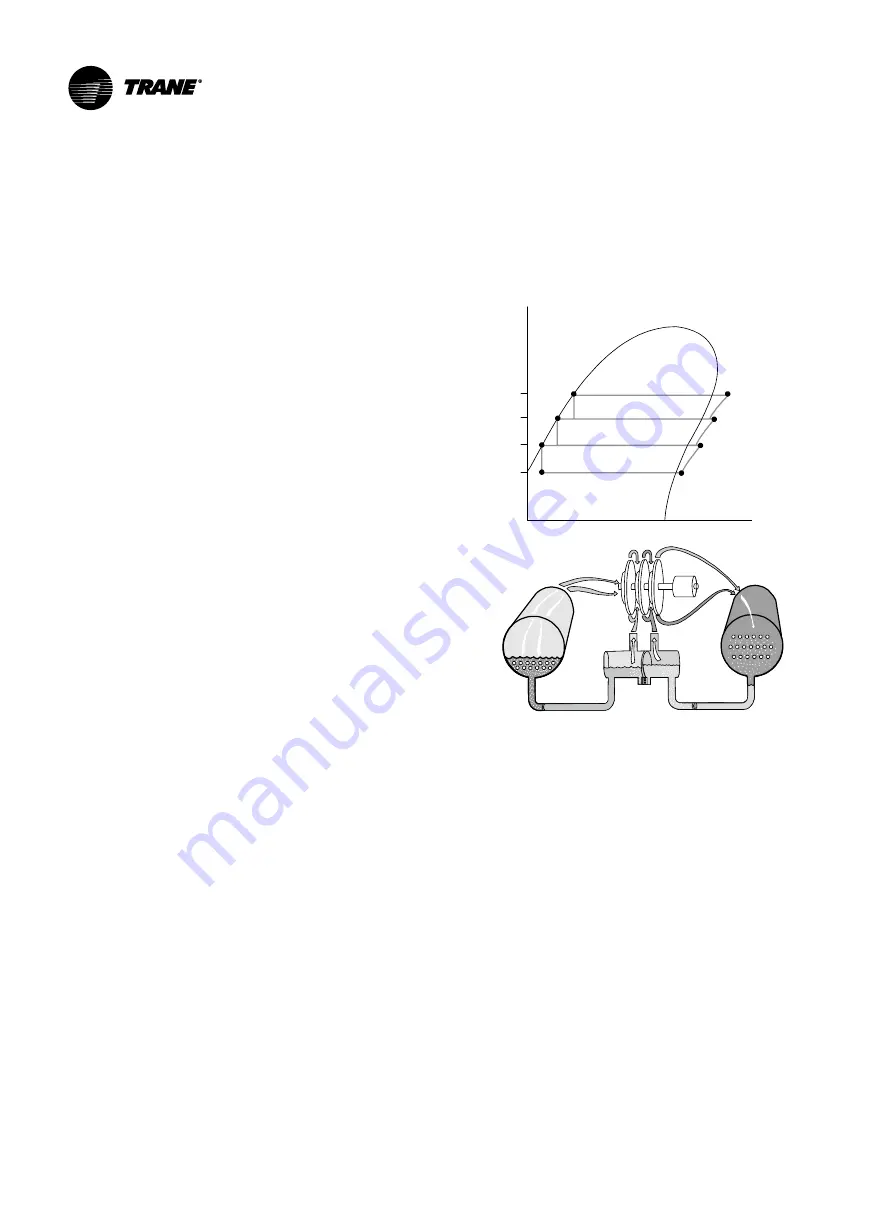
Operating Principles
General Requirements
Operation and maintenance information for models
CVHE, CVHF, CVHG are covered in this section. This
includes both 50 and 60 Hz centrifugal chillers equipped
with the AdaptiView UC800 control system. Please note
that information pertains to all chiller types unless differ-
ences exist in which case the sections are broken down
by chiller type as applicable and discussed separately.
By carefully reviewing this information and following the
instructions given, the owner or operator can successful-
ly operate and maintain a CenTraVac unit. If mechanical
problems do occur, however, contact a qualified service
organization to ensure proper diagnosis and repair of
the unit.
Cooling Cycle
When in the cooling mode, liquid refrigerant is distrib-
uted along the length of the evaporator and sprayed
through small holes in a distributor (i.e., running the
entire length of the shell) to uniformly coat each evapo-
rator tube. Here, the liquid refrigerant absorbs enough
heat from the system water circulating through the evap-
orator tubes to vaporize. The gaseous refrigerant is then
drawn through the eliminators (which remove droplets
of liquid refrigerant from the gas) and first stage variable
inlet guide vanes, and into the first stage impeller.
Note: Inlet guide vanes are designed to modulate the
flow of gaseous refrigerant to meet system capacity
requirements; they also pre-rotate the gas, allowing it
to enter the impeller at an optimal angle that maximizes
efficiency at all load conditions.
CVHE, CVHG 3-Stage Compressor
Compressed gas from the first-stage impeller flows
through the fixed, second-stage inlet vanes and into
the second-stage impeller. Here, the refrigerant gas is
again compressed, and then discharged through the
third-stage variable guide vanes and into the third stage
impeller.
Once the gas is compressed a third time, it is discharged
into the condenser. Baffles within the condenser shell
distribute the compressed refrigerant gas evenly across
the condenser tube bundle.
Cooling tower water circulated through the condenser
tubes absorbs heat from the refrigerant, causing it to
condense. The liquid refrigerant then passes through
orifice plate and into the economizer.
The economizer reduces the energy requirements of
the refrigerant cycle by eliminating the need to pass all
gaseous refrigerant through three stages of compression
(see
). Notice that some of the liquid
refrigerant flashes to a gas because of the pressure drop
created by the orifice plates, thus further cooling the liq-
uid refrigerant. This flash gas is then drawn directly from
the first and second stages of the economizer into the
third-and second-stage impellers of the compressor, re-
spectively. All remaining liquid refrigerant flows through
another orifice plate to the evaporator.
Figure 24. Pressure enthalpy curve 3 stage
condenser
2
3
evaporator
4
P
1
P
3
P
2
P
4
Pressure
(PSI
)
compressor
3rd stage)
high side economizer
low side economizer
compressor
compressor
(2nd stage)
5
6
(1st stage)
7
8
1
Figure 25. Refrigerant flow 3 stage
CVHF 2-Stage Compressor
Compressed gas from the first-stage impeller is dis-
charged through the second-stage variable guide vanes
and into the second-stage impeller. Here, the refrigerant
gas is again compressed, and then discharged into the
condenser. Baffles within the condenser shell distrib-
ute the compressed refrigerant gas evenly across the
condenser tube bundle. Cooling tower water, circulated
through the condenser tubes, absorbs heat from the
refrigerant, causing it to condense. The liquid refrigerant
then flows out of the bottom of the condenser, passing
through an orifice plate and into the economizer.
The economizer reduces the energy requirements of
the refrigerant cycle by eliminating the need to pass all
gaseous refrigerant through both stages of compression
(see
). Notice that some of the liquid
refrigerant flashes to a gas because of the pressure drop
created by the orifice plate, thus further cooling the liq-
uid refrigerant. This flash gas is then drawn directly from
the economizer into the second-stage impellers of the
compressor. All remaining liquid refrigerant flows out of
the economizer, passes through another orifice plate and
into the evaporator.
52
RELEASED 10/Mar/2020 06:59:20 GMT
















































